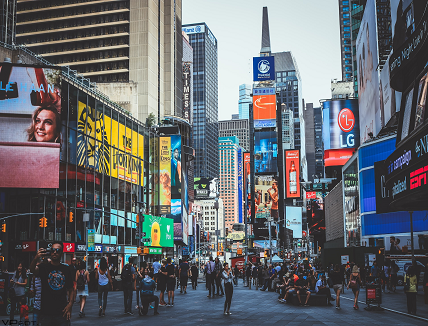
Digital billboards are revolutionizing the world of Out-Of-Home (OOH) advertising. As we move into the future, these billboards are becoming more and more prevalent, and their impact is undeniable. With their ability to display dynamic, eye-catching content, digital billboards are quickly becoming the preferred choice for advertisers looking to make an impact.
One of the most significant advantages of digital billboards is their flexibility. Unlike traditional billboards, which are static and unchanging, digital billboards allow advertisers to display a wide range of content, from still images to videos, animations, and even interactive content. This flexibility means that advertisers can tailor their content to suit their target audience, creating a more engaging and memorable experience for viewers.
As the market for digital billboards continues to grow, we can expect to see even more innovation in the field. From advancements in technology to new creative approaches, the future of digital billboards is bright. In this article, we will explore the world of digital billboards and how they are illuminating the future of OOH advertising.
Understanding Digital Billboards
What are Digital Billboards
Digital billboards are a form of outdoor advertising that use electronic displays to show advertising messages. Unlike traditional billboards that use static images, digital billboards use LED screens or LCD displays with light-emitting diodes to show dynamic and interactive content. Digital billboards can also be programmed to change messages frequently, allowing advertisers to target specific audiences with relevant content.
Digital billboards are typically installed in high-traffic locations such as highways, airports, and shopping centers. They offer advertisers a powerful way to reach a large number of people in a short amount of time. Digital billboards are also more cost-effective than traditional billboards since they can display multiple messages on a single screen.
Types of Digital Billboards
There are two main types of digital billboards: static and dynamic. Static digital billboards display a single message that remains the same for a set period of time. Dynamic digital billboards, on the other hand, can display multiple messages that change frequently.
Dynamic digital billboards are further classified into two types: full-motion and partial-motion. Full-motion digital billboards display video content, while partial-motion digital billboards display static images that change periodically.
Digital billboards can also be classified based on their size and resolution. Larger screens with higher resolution are typically more expensive, but they offer better visibility and greater impact.
OOH Advertising: A New Digital Era
Definition and Importance
Out-of-home (OOH) advertising is a traditional form of advertising that has been around for centuries. It refers to any form of advertising that targets consumers while they are outside of their homes. This includes billboards, posters, transit advertising, and more. OOH advertising is an important part of any marketing mix because it allows brands to reach consumers in a variety of different contexts and locations.
In recent years, OOH advertising has undergone a significant transformation with the rise of digital out-of-home (DOOH) advertising. DOOH refers to any form of OOH advertising that uses digital displays instead of traditional static displays. This includes digital billboards, digital bus shelters, and more.
Digital OOH advertising offers a number of benefits over traditional OOH advertising. For one, it allows for more dynamic and engaging content that can be updated in real-time. Additionally, digital displays can be more eye-catching and attention-grabbing than traditional static displays. This is particularly important in today’s fast-paced world where consumers are constantly bombarded with advertising messages.
OOH vs DOOH
While traditional OOH advertising still has its place, DOOH is quickly becoming the preferred choice for many brands. Here are some of the key differences between the two:
| Traditional OOH | Digital OOH |
| Static displays | Dynamic displays |
| Limited creative flexibility | More creative flexibility |
| Limited targeting capabilities | Advanced targeting capabilities |
| Limited measurement capabilities | Advanced measurement capabilities |
Digital OOH advertising allows for more targeted and measurable campaigns. For example, advertisers can use location data to target specific audiences in specific locations. Additionally, digital displays can be equipped with sensors that can track how many people are viewing the ad and for how long. This allows advertisers to better understand the effectiveness of their campaigns and make adjustments as needed.
Technological Advancements in Digital Billboards
As we continue to see a shift towards digital advertising, digital billboards have become an increasingly popular medium for out-of-home (OOH) advertising. With technological advancements, digital billboards have evolved to become more interactive, engaging, and personalized. In this section, we will explore some of the latest technological advancements in digital billboards.
AR and AI in Digital Billboards
One of the most exciting technological advancements in digital billboards is the integration of augmented reality (AR) and artificial intelligence (AI). AR technology allows advertisers to create immersive experiences for consumers, where digital content is overlaid onto the real world. By using a smartphone or other device, consumers can interact with digital billboards in new and exciting ways.
AI technology, on the other hand, allows for more personalized and targeted advertising. By analyzing consumer data, AI algorithms can create ads that are tailored to the individual viewer. For example, if a digital billboard is located near a sports stadium, AI technology can analyze data to determine which sports teams are most popular in the area. The billboard can then display ads for those specific teams, increasing the likelihood of engagement and conversion.
The Rise of Smart Billboards
Another exciting development in digital billboards is the rise of smart billboards. Smart billboards use sensors and other technology to gather data about their surroundings, such as the weather, traffic patterns, and time of day. This data is then used to display ads that are more relevant to the viewer.
For example, if it’s a hot day, a smart billboard might display ads for cold drinks or ice cream. If traffic is heavy, the billboard might display ads for nearby restaurants or attractions. By using real-time data, smart billboards can create a more personalized and engaging experience for consumers.
Marketing Strategies in OOH Advertising
In OOH advertising, marketing strategies play a crucial role in creating brand awareness and engagement. Here are some key sub-sections that we will cover in this section.
Role of Creativity
Creativity is the lifeblood of any successful OOH advertising campaign. It is what sets a brand apart from its competitors and catches the attention of the target audience. Creativity in OOH advertising can come in many forms, such as bold colors, unique typography, and eye-catching graphics. These elements can be used to create a memorable and impactful message that resonates with the audience.
One way to incorporate creativity in OOH advertising is to use interactive billboards. These billboards allow the audience to engage with the brand by providing them with an experience that is both fun and memorable. For example, a billboard that responds to the movements of people passing by or a billboard that allows people to take a selfie with the brand logo can create a lasting impression.
Storytelling for Brand Engagement
Storytelling is another effective marketing strategy in OOH advertising. It allows brands to connect with their audience on a deeper level by telling a story that resonates with them. The story can be about the brand’s history, its values, or its mission. Whatever the story may be, it should be authentic and relevant to the target audience.
One way to incorporate storytelling in OOH advertising is to use sequential billboards. These billboards tell a story in a series of images or messages, creating a narrative that engages the audience. For example, a billboard that shows a person struggling with a problem and then another billboard that shows the same person finding a solution with the help of the brand can create a sense of empathy and connection with the audience.
Role of Data in Digital Billboards
As digital billboards continue to gain popularity, the role of data in OOH advertising has become increasingly important. With the help of data, we can now target the right audience, at the right time, and in the right place. In this section, we will discuss the role of data in digital billboards and how it is shaping the future of OOH advertising.
Data-Driven Ad Placement
One of the biggest advantages of using data in digital billboards is the ability to place ads in the right location. By analyzing data such as traffic patterns, demographics, and time of day, we can determine the most effective locations for our ads. For example, if we know that a particular area has a high foot traffic during lunchtime, we can use that data to place our ad in a location that will be seen by the most people during that time. This data-driven approach to ad placement allows us to maximize the impact of our ads and ensure that they are seen by the right people.
Understanding the Target Audience
Data is also crucial in understanding the target audience for our ads. By analyzing data such as age, gender, income, and interests, we can create ads that are tailored to specific groups of people.
For example, if we know that a particular area has a high concentration of young professionals, we can create an ad that speaks directly to that demographic. By understanding our target audience, we can create more effective ads that resonate with the people who are most likely to be interested in our products or services.
Cost and ROI of Digital Billboards
Investment in Digital Billboards
Investing in digital billboards can be a significant expense for businesses. The cost of a digital billboard can range from $30,000 to $500,000 depending on the size, location, and features. Additionally, there are ongoing costs associated with operating and maintaining digital billboards, such as electricity, content creation, and software updates.
Despite the high cost of investment, digital billboards can offer many advantages over traditional billboards. For example, digital billboards can display multiple ads in rotation, allowing businesses to reach a wider audience with a single billboard. They can also be updated immediately, allowing businesses to respond quickly to changing market conditions or events.
Measuring the ROI
Measuring the return on investment (ROI) of digital billboards can be challenging, but it is essential to determine the effectiveness of the advertising campaign. One way to measure the ROI of digital billboards is to track sales data before and after the campaign. This can help determine if the campaign led to an increase in sales and revenue.
Another way to measure the ROI of digital billboards is to track engagement metrics, such as views, clicks, and shares. This can help determine if the campaign is reaching the target audience and generating interest in the product or service.
The ROI of digital billboards can vary depending on factors such as location, audience, and message. However, studies have shown that digital billboards can have a significant impact on brand awareness and purchase intent.
Case Studies
Here are some examples of how big brands have used digital billboards to their advantage:
Google’s Use of Digital Billboards
Google is no stranger to OOH advertising, and they have used digital billboards to promote their products and services. One example is their “Year in Search” campaign, which featured a series of digital billboards that showcased the most searched topics of the year. The campaign was a huge success, and it helped to reinforce Google’s position as the go-to search engine.
Amazon’s OOH Campaigns
Amazon has also used digital billboards to promote their products and services. One example is their “Prime Day” campaign, which featured a series of digital billboards that showcased the deals available to Prime members. The campaign was a huge success, and it helped to drive sales and increase brand awareness.
YouTube Ads on Times Square
YouTube has used digital billboards to promote their platform in one of the most iconic locations in the world – Times Square. They have run several campaigns that feature user-generated content on digital billboards, which helps to showcase the platform’s diverse community. The campaigns have been a huge success, and they have helped to reinforce YouTube’s position as the go-to platform for video content.
Overall, these case studies demonstrate how digital billboards can be used to effectively promote products and services. By using eye-catching visuals and creative messaging, brands can capture the attention of their target audience and drive engagement.
Final Words About Digital Billboards
Digital billboards are the future of OOH advertising, and they have the potential to create a lasting impression on the audience. With their bright and engaging displays, digital billboards can capture the attention of passersby and convey a message in a way that is both captivating and memorable.
One of the key advantages of digital billboards is their flexibility. Advertisers can easily change the content of their ads to reflect the time of day, weather conditions, or any other relevant factors. This means that digital billboards can be used to promote a wide range of products and services, and can be tailored to specific audiences.
In addition to their flexibility, digital billboards are also highly engaging. They can incorporate animations, videos, and other interactive elements that draw the viewer in and encourage them to interact with the ad. This can help to create a sense of connection between the viewer and the brand, and make the ad more memorable.


















